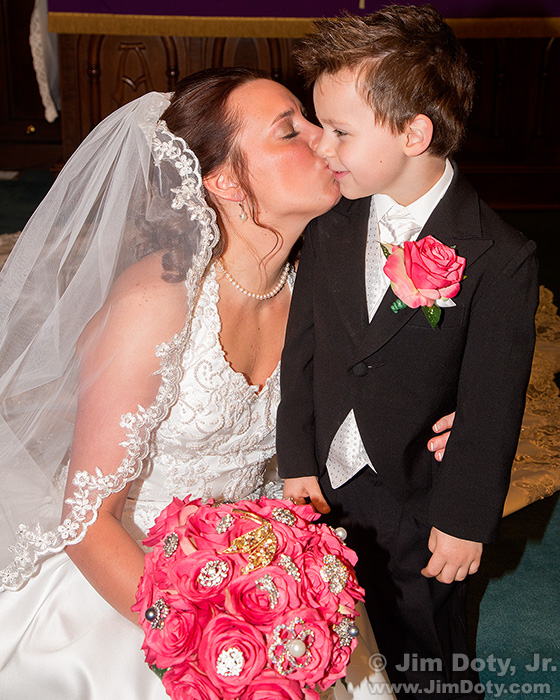I recently had the following online conversation with a friend who is an experienced photographer (which explains why I didn’t answer some of these questions in more detail).
Q: I’m shooting my first wedding. Do you have some tips?
A: There are two books you should buy or check out at the library or order on inter-library loan: Steve Sint’s Wedding Photography, Art Business and Style and Bambi Cantrell’s The Art of Wedding Photography. The versions I have for both books are the early “film” books, but that doesn’t diminish at all the value of the advice. (And a lot of photographers like Cantrell’s first book better than her more recent “digital” version.) Cantrell excels at the candid, photojournalistic style. Sint excels at posed portraits.
No matter what the bride says before the wedding (some think they only want photojournalistic photos), her family is going to want posed portraits of the bride and groom, wedding party, and family – some of whom may rarely all be together.
Both books are excellent, must read books. You can buy both of them on this page at my photography store.
Q:Â Thanks, I’ll have to look at those!
In my head, I’m thinking… for the ‘getting ready’ of the bride and groom, I will bring my 50mm and do some nice artsy photos. For the ceremony, I’ll shoot with my 24-105 with a high aperture and on camera flash… so I don’t screw anything up (lol), then I’ll do posed family portraits after… then for the bride and groom go back to artsy and creative?
I know for the ceremony, I’d rather focus on technical than creative… and I want to make sure everything is tack sharp, and light nicely.
So, for on-camera flash, should I bounce it off a wall, or ceiling? I really hate to point it right at the subject…
A: Your 50mm artsy “before” photos, followed by the 24-105 for the ceremony is a good plan.
One of the reasons weddings are a challenge is I don’t usually don’t have time to do what I would prefer to do, use some powerful off camera studio flashes and reposition them for each separate group photo so they are in the ideal position, but that just isn’t going to happen in the rush-rush of a wedding where you have to turn out a ton of groups and poses in very limited time. Studio lights are a great idea if you can do some location portraits of the bride and groom some day prior to the day of the wedding.
Bounce flash is a good idea in pre-wedding shots when you have a low, white ceiling (bouncing off a ceiling is my preference), or a white wall that is nearby (within 4 or 5 feet) if the ceiling is too high (more than 8-10 feet). The wall or ceiling needs to be white or close to white (like an off white or egg shell white). If the wall or ceiling is some other color, That color will create an unnatural tint in the photos.
For the ceremony, bounce flash is almost always out of the question since the walls and ceiling are usually miles away. So it is on-camera flash pointed right at the subject (which is my least favorite way to shoot). The ISO is set to 400 for small groups and ISO 800 for large groups to allow for an f/8 aperture for small groups and an f/11 aperture for large groups where more depth of field is necessary so everyone looks sharp. Sometimes I use ISO 800 just to make sure the ambient light exposure is ok without too slow a shutter speed.
Assume the Guide Number for your standard shoe mounted flash (at ISO 100) is about 100 (no matter what the manufacturer says). When you are 20 feet away for a large group portrait (you shouldn’t move in close with a wide angle focal length because distortion will make the people on the edges look wider) at ISO 100, your aperture will be around f/5 which won’t give you enough depth of field for a group photo. A 24mm or 28 mm focal length (on a 24-105 lens) is an absolute no no for a group photo due to distortion at the edges of the frame. Great for landscapes (and some overall sanctuary photos at a wedding) but not for people. To get to f/8 or f/11 you have to jump the ISO to 400 or 800 or the photo will be seriously underexposed, leading to a lot more digital noise.
Q: Should I just put the flash on TTL? I rarely use my Speedlite, and never on camera.
A: I use ETTL all the time. During the hectic pace at many weddings, there is precious little time to manually calculate the flash exposure. (I used to do it back in my film and manual flash days, but it was not fun.)
I did “plus” (+)Â flash exposure compensation when the bride’s gown was prominent in the exposure, and “minus” (-)Â flash compensation when shooting the groom and his mates with lots of black tuxedos. I would double check the histogram to make sure I wasn’t burning out pixels on the right, or if the histogram had shifted too far to the left. Of course with a bunch of guys in black tuxes, the histogram should be shifted a bit to the left.
Every time I would shoot a new group, I would check the first photo and it’s histogram to make sure everything was ok, and adjust the flash exposure compensation as necessary. This is a pain to do on the flash unit itself (too many steps), so I do it with the flash exposure compensation button on the camera (top right). Just tap the button, spin the dial a notch or two and you are done. Much faster than fiddling with compensation on the flash.
Q: Thanks Jim!! This is helpful!!

